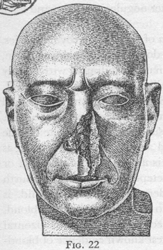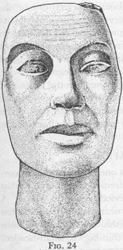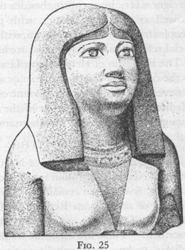|
(Chapter IV,
section 4)
Civilized
Men in Egypt
(4) CIVILIZED MEN IN EGYPT Certainly the most satisfactory
area in the whole world for the racial study of a people of antiquity
is the valley of the Nile. Over four thousand Egyptian skeletons, covering
a period of some seven thousand years, have received anthropometric
attention. One Egyptian series, consisting of nine hundred males, is
the most extensive group of crania of a single sex and from a single
place ever assembled. It is possible, therefore, to study variability
and change in this isolated valley with delicate precision, for in one
district, the region of Upper Egypt about Abydos and Thebes, the cranial
material is more abundant than that of any age from any other region
of the same size in the world.11
Furthermore, from the beginning of dynastic times until the arrival
of Islam, Egyptian painters and sculptors recorded faithfully, often
in colors, the physical appearance of their living countrymen, as well
as of many different kinds of foreigners. At the same time, the climate
of the Nile Valley, and the skill of embalmers, have preserved intact
the hair, skin, and dried muscles of both natural and artificial mummies,
from the predynastic period onward. With this abundance of evidence,
we should be nearly? as familiar with the racial characteristics of
tire ancient Egyptians as with those of the people of our own day.
Geographically, Egypt is not unified. In the first place, the Delta,
which resembles early Sumeria in its climatic conditions, is a marshy
series of water ways, continuous with the coasts of Palestine and Lybia,
and easily attainable from both directions, as well as from the sea.
It, and to a lesser extent, Lower Egypt, as well, forms an easy route
of passage from Asia to North Africa without touching most of Egypt
proper. It is possible, therefore, that even in dynastic times movements
of racial importance passed from western Asia to North Africa over this
coastal route, without affecting the population of Egypt in any notable
way. Upper Egypt, on the other hand, is a narrow valley hemmed in by
cliffs on either side. Beyond these cliffs lie plateaux, which during
the pluvial periods were well?watered and covered with grass and game.
There was only one gateway to Egypt from the south?down the Nile?and
during the dynastic period the Egyptian kings kept garrisons on their
southern boundaries to prevent immigration from this quarter.
The cyclonic rain belt which moved northward from the Saharan and Arabian
deserts in the general post?glacial readjustment of climate also took
a westward direction.12 For this reason, a climate favorable
for hunters and gatherers persisted longer in Egypt than in Mesopotamia.
At the same time, this movement may have had much to do with the migration
of peoples crossing North Africa from cast to west, keeping ahead of
the zone of serious desiccation. Morocco was the last of North Africa
to dry, and in parts of that country cedar forests and grassy uplands
still remain.
The archaeological sequence in Egypt, which has been well worked out,
begins with the lowest Palaeolithic and continues without a gap until
historical times. During the pluvial and early post?pluvial periods,
however, the swampy tree?fringed valley was not the most favorable hunting
ground, and Palaeolithic and Mesolithic food?gatherers ranged by preference
over the open grasslands to either side, making only occasional visits
to the river banks. As the plateaux grew increasingly arid, many of
the hunters who did not migrate westward moved into the still moist
valley, toward which the game upon which they lived must have been converging.
One such concentration of food?gatherers is seen in the Sebilian culture
of Upper Egypt.13 The skeletal remains from this culture,
which have not yet been published, are said to anticipate in physical
type the predynastic, placing a fine Mediterranean type in pre?Neolithic
times.14
In another part of Upper Egypt, the earliest known of the sporadic agriculturalists,
who at the same time or soon afterward began to exploit the favorable
environment of the Nile Valley, were the so?called Tasians, named after
the type site of their culture at Deir Tasa. At the tithe of their occupation,
this part of the Nile Valley was still swampy, with large trees growing
at the fringes of the marsh. In view of these climatic conditions, it
is estimated that this culture may have been introduced as early as
5000 or even 6000 B.C.15
Although the physical type of the Tasians has not yet been fully described,
Brunton's preliminary notice informs us that the few skulls as yet found
are large, thick?walled, and strong in muscle relief, with heavy browridges
The cranial form, while prevailingly dolichocephalic, includes some
brachycephals.16 The faces are broad, the orbits square,
the lower jaws deep, wide, and square, with flaring gonial angles and
projecting, bilateral chins. Judging from the drawings of one example
published by Brunton, we may deduce that they were orthognathous, and
in this case at least, mesorrhine They seem to belong to a purely white
category and we may hazard a guess that they represent an Upper Palaeolithic
strain of Afalou or Early Natufiian type, forming a link between Algeria
and Palestine. They were not, however, important in the ultimate formation
of the Egyptian people, for in subsequent times they seem, both culturally
and racially, to have disappeared.
Another early Neolithic civilization of Egypt which left no clear traces
in the dynastic culture was that of the Fayum people and the Merimdians
of the Delta, who, contemporaneously with the Tasians, and following
the Sebilians, grew barley, emmer wheat, and flax along the shores of
the Fayum Lake and the estuaries of the Delta. They also kept herds
of cattle, and especially of swine. Their technology bridges the gap
between a Capsian Mesolithic and a full Neolithic. Their pottery, a
thick black ware decorated by incision, resembles early ceramic types
of Neolithic western Europe and of Anatolia.
The importance of these people is that they probably represent the prototype
of the Neolithic agriculturalists who moved westward along the shore
of North Africa to Morocco, and over into Spain, whence they spread
the Neolithic economy, with emmer flax, and swine, to the Swiss lakes
and to the Rhine.17 Although they may have had little importance
for Egypt, they had much for Europe. Their appearance in the Fayum and
the Delta is dated at about 5000 B.C., and their disappearance about
4000 B.C. One millennium later they or people like them appeared in
western Europe.
The skulls of these people, which consist mostly of females and infants,
are all dolichocephalic and Mediterranean There is no trace of negroid
influence and the skulls are said to be larger than those of predynastic
Egyptians to be described shortly.18
After this excursion let us return to Upper Egypt to a number of sites
close to that section of the valley in which the Tasians had previously
lived. From the type site, Badari, come the earliest skulls of a definitely
Egyptian group which have yet been discovered. These Badarians lived
about 4000 B.C., after the climate had become considerably drier than
it was in Tasian times, so dry, in fact, that in many cases the skin
and hair of their dead have been naturally preserved. The skin was apparently
brunet white, while the hair was black or dark brown in color, thick,
of fine texture, and usually wavy in form.
Although the Badarians, like the Tasians and Merimdians, still hunted
and fished to enhance their larders and vary their diet, they lived
primarily by agriculture and by herding cattle and sheep. Unlike the
Merimdians they raised no pigs. By hammering copper they were entering
the transition from the Neolithic to the Metal Age. They navigated the
Nile in ships, whose shapes are revealed by pottery models, but we cannot
be sure that they sailed them. These Badarians were undoubtedly newcomers
to Upper Egypt who displaced the Tasians and perhaps other predecessors.
It is very difficult to identify the sexes of Badarian skulls, for the
type is a delicate and feminine one, showing very little muscular development.19
For this reason, the various investigators who have measured Badarian
skulls have in no two cases agreed on their sexing, and the means vary
accordingly, but with the most extreme division, the sex ratios are
still unusually small, even for an Egyptian series.
The Badarian series is the earliest cranial sample of any numerical
length which has yet been obtained from any part of the world. It is
our first series, unified in little and place, which is ample enough
to be studied by accurate statistical methods. These show that the series
is not very variable, but its variability is no less than that of many
modern populations. From this Morant concludes "In the last six thousand
years there appears to have been little change in the variability of
racial populations."20
The Badarian type represents a small branch of the Mediterranean racial
group. The head is unusually high in comparison to the other dimensions,
and the facial skeleton is in the absolute scale unusually small; the
mandible is small, narrow and light. Its mean male bicondylar diameter
is the smallest known, while the bigonial diameter of 91.6 mm. is also
extremely low.
Although the Badarian type is definitely related to that of the succeed
ing predynastic people, it is distinguished from it in a number of ways.
The Badarian skulls are more prognathous than those of their successors,
and have higher nasal indices. The nasal index is just on the line between
mesorrhiny and chamaerrhiny In fact, while the prognathism and nose
form would suggest a negroid tendency, this cannot be established, since
the hair form is definitely not negroid.
Morant shows that the Badarian cranial type is closely similar to that
of some of the modern Christians of northern Ethiopia ? who incidentally
do not show negroid characteristics in the skull ? and also to the crania
of Dravidian?speaking peoples of southern India. One might add that
living Somalis show a close approximation to this physical type in most
respects, and the extremely narrow jaw in which the Badarians seem to
reach a world extreme may be duplicated among both Somalis and the inhabitants
of southern India. In Europe, the closest parallel to the Badarian type
is found among modern Sardinians, but this is not as close as their
relationships to outer and later Egyptians.
On the basis of these racial comparisons, it seems reasonable to suggest
that this Badarian physical type may have come from the south, near
the headwaters of the Blue Nile. It may represent an early Hamitic racial
strain, which persists despite some negroid admixture in Ethiopia and
Somaliland to the present day.
The Badarian was succeeded in Upper Egypt by a sequence of cultures
which may be treated under the collective term predynastic. In predynastic
Egyptian times, the inhabitants of Lower Egypt, that is the region around
Memphis and the modern Cairo, were physically and culturally distinct
from those of Upper Egypt. The Egyptian writing was developed in Lower
Egypt where reeds, birds, and other natural objects typical of that
environment were incorporated into the syllabic and alphabetical signs.
In predynastic times, there were two kingdoms of Lower and of Upper
Egypt. The union of the two under Menes, around 3000 B.C., marks the
beginning of the dynastic tradition. Predynastic times may be considered,
therefore, to have occupied most of the preceding millennium.
In Upper Egypt the early predynastic physical type is best represented
by the series front Naqada.21 (See Appendix I, col. 6.) The
Naqada people, although they resembled the Badarians in many respects,
yet differed from them sufficiently in others to assure us that these
were two populations of separate though related origins. The Naqada
people were fairly tall, with a mean stature of 167.5 cm. for eighty
males. They were probably taller than the Badarians, although we have
no definite data on Badarian stature. Both heads and faces were wider
and larger than those of the Badarians; the noses were narrower, and
there was less prognathism.
The less numerous Badarians were probably absorbed into the Naqada population,
though there is no direct evidence to confirm this assumption.
In Lower Egypt lived another group of Mediterranean predynastic people
who differed from the Upper Egyptians in certain noticeable ways. The
heads were broader, the cranial indices higher, reaching a mean of 75,
whereas the Upper Egyptian mean is nearly 72. The vault height is less,
the face is no broader, but somewhat longer, and the nasal index is
lower.
The two types from Upper and Lower Egypt represent the extremes of a
purely native Egyptian population, but from the beginning of dynastic
times, around 3000 B.C. until Ptolemaic times, the numerous series which
give an excellent picture of the progress of racial continuity and change
in Egypt show the interactions of these two types. The racial history
of Egypt in the course of three thousand years was simply the gradual
replacement of the Upper Egyptian type by that of Lower Egypt.22
(See Appendix 1, cols. 7, 8.) As one looks at the tables from century
to century, one sees that the crania increased gradually in breadth
from 131 to 139 mm., and the faces from 124 to 129 min. Ancient Egypt
must remain the most outstanding example yet known in the world of an
important, naturally isolated region in which native racial types were
permitted to develop their own way for several thousand years completely
uninfluenced by foreign contacts.
Modern Copts, who probably represent the ancient Egyptian type more
faithfully than the :Moslem population, have diverged from the earlier
types only in a reduction of the skull length from about 183 mm. to
177 mm. Therefore, evolutionary change in Egypt consisted entirely of
a slight reduction of head length, and in places of a lengthening of
the face, and a narrowing of the nose; but the change has not been notable.
Changes in physical type in any part of Europe within the last five
hundred years have been much greater than in Egypt during five thousand.
The wealth of contemporary illustrative material from Egyptian art sources
may be divided into two classes, conventional representations and portraits.
The former show a definite and well?recognized type; slenderbodied and
wiry, with narrow hips and small hands and feet. The head and face are
those of a smoothly contoured fine Mediterranean form.
 
 
The portraits, on the other hand, show two things
in particular: that there was considerable individual variation in bodily
build as in head and face form within the dolichocephalic and mesocephalic
range, and that many of the officials, courtiers, and priests, representing
the upper class of Egyptian society but not the royalty, looked strikingly
like modern Europeans, especially long?headed ones. This is due perhaps
to the fact that the Egyptian nose was not typically high rooted, like
those of the Mesopotamians as depicted in their art; and also, perhaps,
because the portraiture, at least of the men, shows a greater angularity
of line and form than do the conventional representations.
There may also have been some distinction of type in the royal families,
for the rulers often have that extremely dolichocephalic head form,
coupled with a sloping forehead and high nasal aquilinity, with highly
excavated nostrils, seen so typically in the familiar mummy of Rameses
III, as in the living emperor of Ethiopia, Hailie Selassie. This strain
may well have been derived in most ancient times from the headwaters
of the Nile.
The pigmentation of the Egyptians was usually a brunet white; in the
conventional figures the men are represented as red, the women often
as lighter, and even white. Although the hair is almost inevitably black
or dark brown, and the eyes brown, Queen Hetep?Heres II, of the Fourth
Dynasty, the daughter of Cheops, the builder of the great pyramid, is
shown in the colored bas reliefs of her tomb to have been a definite
blond. Her hair is painted a bright yellow stippled with fine red horizontal
lines,23 and her skin is white. This is the earliest known
evidence of blondism in the world. Later Egyptian reliefs, however,
frequently represented Libyans as blond,24 and in early Egyptian
times, the territory of the Libyans extended to the Delta itself. The
Egyptian representation of foreigners is quite accurate; besides the
Libyans, who have Nordic features as well as coloring, Asiatics, with
prominent noses and curly hair, sea peoples from the Mediterranean,
with lighter skins and a more pronounced facial relief than the Egyptians,
are also shown, as well as negroes. The blondism of Hetep?Heres II apparently
belonged to the Delta and to the connections outside to east or west,
rather than to Egypt proper, for it never recurred as an important or
characteristic Egyptian trait. The Mediterranean pigmentation of the
Egyptians has probably not greatly changed during the last five thousand
years.
Notes:
11 Worant, G. M., Biometrika, 1925, p. 4.
12 This summary of climatic changes in Egypt is based on Childe, V.
G, New Light on the Most Ancient East, pp. 49- 51 .
13 Childe, op.. cit., p. 35.
14 Leakey, L. S, B., Stone Age Africa pp. 177 -178.
15 Brunton, Guy, Antiquity, vol. 3, #12, Dec., 1929,
pp. 456-457.
16 Menghin, O., Lecture at Harvard University April 6, 1937.
17 Childe V. G., op cit., p. 64.
18 Terry, Douglas, SAWV, Jahrgang, 1932, #1 ?4, pp.
60-61.
19 Morant, G. M., Biometrika, 1927, vol. 27, pp. 293-309.
20 Ibid., p. 306.
21 Morant G. M., Biometrika, vol. 17, 1925, pp. 1?52.
22 Morant, op. cit., 1925.
23 Reisner, G. A., BBMF, vol. 25, #151, October, 1927,
pp. 64?79.
24 Bates, O., The Eastern Libyans.
|



